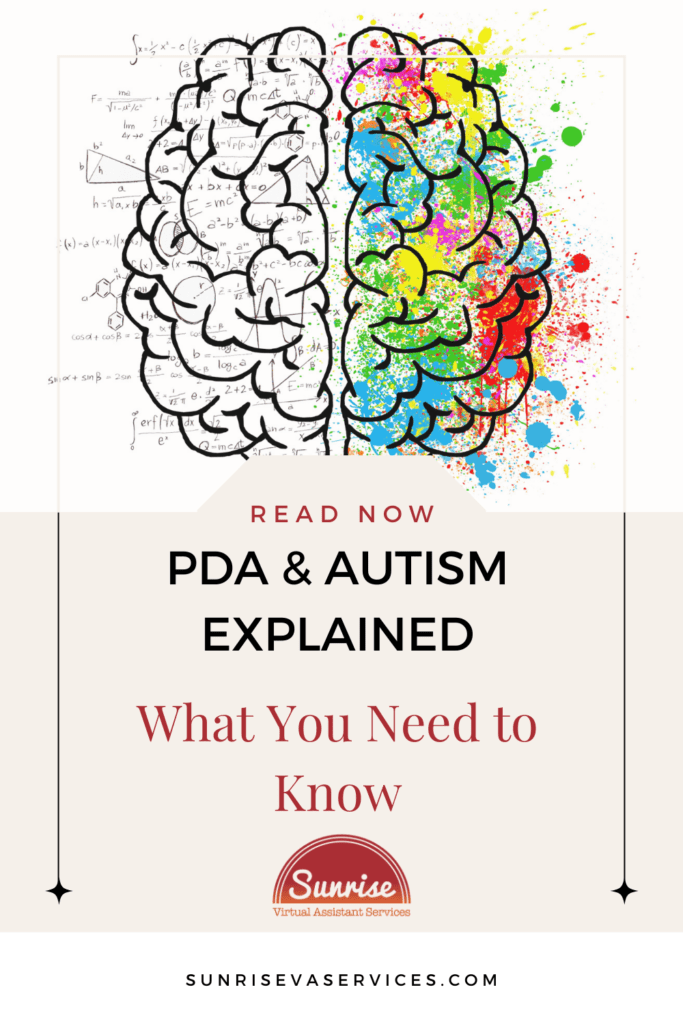Do you know the link between PDA and autism?
Pathological Demand Avoidance (PDA) is a subtype of autism spectrum disorder (ASD), recognized for its distinct characteristics and the profound, unique challenges it presents in everyday life.
For autistic individuals, particularly those with a PDA profile, navigating the world can be a journey filled with intense need for autonomy and extreme resistance to direct demands.
This blog explores PDA and autism, shedding light on the lived experiences, the unique aspects of PDA, and how we can create supportive environments for PDA individuals.
If you are a neurodivergent adult looking for answers, a family member of someone with PDA, or an ally who wants to learn, this article is for you.
Let’s unpack the concept of PDA, demystify its various nuances, and discuss how we can embrace a more inclusive understanding of autism.
What is PDA?
Pathological Demand Avoidance (PDA) refers to a behavioral profile within the autism spectrum, first identified by British psychologist Elizabeth Newson.
PDA is characterized by an overwhelming need to avoid or resist everyday demands, often driven by high levels of anxiety.
People with Pathological Demand Avoidance (PDA) have some pretty interesting ways of managing their feelings and maintaining a sense of control.
Unlike others on the autism spectrum, people with PDA often use a blend of social skills and role-playing.
Sometimes, their strategies might come across as a bit manipulative, but they stem from a desire to cope with their intense anxiety. It’s all about finding their own unique path to feeling secure and comfortable!
It is worth noting that PDA is not currently recognized as a separate diagnosis within the DSM-5 (otherwise known as the Diagnostic and Statistical Manual of Mental Disorders) or ICD-11 but is increasingly acknowledged as a distinct profile of autism.
While PDA shares some commonalities with disorders like oppositional defiant disorder (ODD) or conduct disorder, what sets it apart is the underlying cause.
For individuals with PDA, their extreme demand-avoidance behaviors stem from intense anxiety rather than a defiance of authority or deliberate non-compliance.
Characteristics of PDA
PDA behaviors can vary widely among individuals, but certain distinct characteristics often emerge, including:
- Extreme Resistance to Demands: This includes both direct demands (e.g., “Please clean your room”) and indirect social expectations.
- High Levels of Anxiety: Intolerance of uncertainty and sensory overload often drive PDA behaviors.
- Use of Social Strategies: PDA individuals may use humor, charm, or even role play to deflect demands.
- Intense Need for Control: This persistent drive to maintain autonomy can manifest in social interactions, family settings, and daily life.
- Extreme Emotional Responses: Panic attacks, meltdowns, or displays of anger may occur when demands feel overwhelming.
- Sensory Sensitivities: Like many autistic people, PDA individuals often experience sensory issues, including sensitivity to noise, textures, or lights.
Understanding these characteristics is crucial in distinguishing PDA from other behavioral patterns and providing genuine, appropriate support.
How PDA Impacts Daily Life
For many individuals with PDA, the everyday demands of life can create overwhelming anxiety. This intense anxiety can pose unique challenges, impacting aspects like education, work, and social interactions.
It’s important to recognize these struggles and approach them with understanding and compassion.
- Education and Learning
School can be really tough for adults with Pathological Demand Avoidance (PDA). The usual setups that depend on routines, rules, and authority can clash with their strong need for independence.
For example, if the curriculum is too rigid, it might make them want to avoid school altogether or even skip out on classes.
With flexibility and understanding, customized approaches can lead to positive outcomes.
Collaborative learning environments and low-pressure tasks can actually enhance accessibility in education.
- Social Interaction
Social situations often come with implicit demands, such as adhering to unspoken social rules or maintaining eye contact.
These expectations can be overwhelming for individuals with PDA (Pathological Demand Avoidance).
To cope, they may use social strategies like role play, which can help manage social expectations. However, these strategies can sometimes be misunderstood by their peers.
Psst… are you neurodivergent? Here are 5 communication strategies you can try!
- Mental Health and Well-Being
Dealing with high anxiety and the pressure of daily life can really take a toll on people with PDA.
It’s important to offer emotional support and come up with some coping strategies to help improve their quality of life.
Personal Insights from the PDA Community
Hearing firsthand accounts can be incredibly validating for PDA individuals and educational for their support networks.
One PDA adult described feeling an “intense need to control my environment to manage my anxiety.”
Another shared, “Role playing allowed me to fit into social situations, but it was exhausting masking my true self.”
Sharing similar experiences within the PDA community can foster a sense of belonging and reduce the stigma around PDA behaviors.
The PDA Society, a valuable resource in the United Kingdom, and organizations like the Autistic Self Advocacy Network in the United States provide platforms for these crucial conversations.
Strategies to Support Individuals with PDA
Support for neurodivergent individuals requires empathy, flexibility, and understanding of their unique characteristics.
Here are some strategies for creating a truly supportive environment at home, school, or work:
- Flexible, Non-Confrontational Approaches
Avoid using direct demands.
Try framing requests as choices or invitations.
Instead of “Write the monthly sales report” try, “Would you like to work on our monthly reports or take a break first?”
- Focus on Collaboration
Work together to develop solutions that give the individual a sense of control. Use collaborative problem-solving to address challenges.
- Offer a Safe Space
Create environments where sensory sensitivities are minimized and the intensity of demands is reduced. A predictable and calming space can significantly lower anxiety levels.
- Promote a Sense of Autonomy
Respect the PDA individual’s need for autonomy and involve them in decisions about their daily activities.
- Develop Emotional Regulation Skills
Therapy sessions can help most individuals identify their triggers and create coping mechanisms for extreme anxiety. An experienced therapist with knowledge of neurodivergence is crucial.
- Educate Support Teams
Whether it’s family members, educators, or employers, everyone interacting with a PDA individual should understand their distinct profile. Training is available through organizations like the National Autistic Society.
Creating Inclusivity for PDA and Autism
Creating an inclusive and understanding environment for neurodivergent individuals requires collective effort and awareness.
Practical tips for promoting acceptance include:
- Educating Others
Raise awareness about PDA behaviors and their underlying causes among your social circles. Use resources from the PDA Society and similar organizations to share accurate information.
- Reducing Stigma
Challenge stereotypes and emphasize the unique strengths of PDA and other autism profiles. Advocate for identity-first language, such as “autistic individuals” instead of “people with autism.”
- Building Community
Join or create spaces where PDA individuals and their families can connect. For neurodivergent entrepreneurs, communities like AuDHD Asset provide valuable resources and networking opportunities.
Resources for PDA and Autism Support
If you’re looking for further guidance, these organizations and tools can help you support PDA individuals and learn more about the condition:
- PDA Society (United Kingdom): Comprehensive, up-to-date information on PDA, including advice for families and educators.
- National Autistic Society (UK): Resources on autism spectrum disorders, including PDA.
- Autistic Self Advocacy Network (United States): Advocacy and support for autistic individuals by autistic individuals.
- Extreme Demand Avoidance Questionnaire (EDA-Q): A valuable resource for understanding PDA behaviors.
Join the Conversation
Navigating life with PDA and autism can be challenging, but it doesn’t have to be isolating. Share your experiences, struggles, and victories with a community that understands. Consider joining spaces like AuDHD Asset, a support group for neurodivergent entrepreneurs, or exploring PDA-specific forums.
Together, we can build a more inclusive world where everyone feels seen, heard, and valued. For more updates and resources about PDA and Autism, join our newsletter or become part of our engaging community.
You’re not alone, and your story matters.


